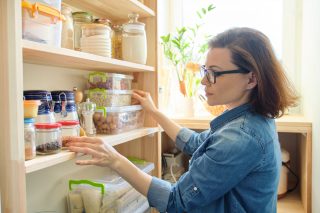10 Sustainable Living Quarantine Hacks
While we’re each prioritizing our health by staying home to protect ourselves against the coronavirus, you’ll be happy to know that you can still do your part to protect the planet. In fact, there are at-home sustainable choices that you can make to help ensure that the outside world continues to be as healthy and green. Believe it or not, green living is still possible – even while sheltering during COVID-19.
Since the beginning of lockdown, various cities around the world have noted the positive impact that the act of staying home has had on the planet, with less pollution affecting the planet. However, as we’re spending more time indoors, there is a fear that the increased energy use and food usage may serve to harm the planet in the long run. Thankfully, even in the comfort of your own home, you can still continue to make a difference for the planet, and here’s how.
1. Start A Compost Pile
Throwing away food means that it will find its way to landfills, which will then contribute to methane production and that’s one of the worst things that could happen to the environment.
Thankfully, if you have a backyard, you can help to prevent this by creating your own compost heap. Aside from reducing your carbon footprint, composting can also help to add nutrients to your soil and it can even reduce the need for fertilizers.
2. Trying To Save Energy
We’re spending a lot of time indoors, and that means we’re spending a lot of time on our devices and appliances. This of course, means that there is a sharp uptake in energy use, which can be harmful to the environment.

While it’s understandable that you need the various devices in your home to keep up with work, there are measures you can take to save energy. These include:
- Turn off and unplugging electronics and small appliances when not in use
- Power down your computers, screens, and printers at the end of each day.
- On your next break, avoid the TV and console and pick up a book instead.
3. Save Water
It’s important to monitor our water consumption as doing so can help to prolong the lifespan of rivers and lakes – both of which are crucial for a healthy ecosystem.
Ways in which you can save water in the household include:
- Turning off the water while you’re brushing your teeth or shaving
- Wash produce in a pan of water instead of a running tap
- Defrost food in the fridge instead of using water
- Only boil the amount of water that you need in a kettle
- Check your toilet and taps for leaks
- Take shorter showers
- Put a plastic bottle in your toilet tank
4. Grow Your Own Sustainable Garden
Aside from being a great stress-relieving hobby, growing your own garden helps you to grow your own food. It also helps to reduce your carbon footprint and air pollution.
You can also use your composting waste to help with your home garden.
![gardening [longevity live]](https://www.longevitylive.com/wp-content/uploads/2019/07/gardening-hand-harvest-9301-320x212.jpg)
5. Use Reusable Bags When You Go Out
Plastic waste continues to be one of the biggest threats currently plaguing the environment.
However, you can do your part by bringing reusable bags to the store when you shop and avoiding single-use plastic bags.
You can also replace any single-use plastic water bottles that you have with glass bottles.
6. Buy Fresh And Local
Why should you buy locally? Well:
– It’s easily accessible
– The produce is fresher
– Less packaging is used
– Fewer food miles which means a lower carbon footprint
– You’ll help to support farmers and fisher folk during this critical time.
7. Buy Only What You Need

Chances are you don’t need that extra roll of toilet paper. Considering the fact mostly non-essential stores are closed, you’re probably surprised at how much money you’ve spent by not spending it on things that you don’t actually need. That said, before you head to the shops for a top up, make sure that you take inventory and create a list of what you need. Doing so will help to reduce the risk of wastage.
8. Spring Clean
Now would be a great time to do that spring-cleaning that you’ve always been putting off.
Go through every room and cupboard in your house, decluttering every corner before making your way to the next. When you’re done, make sure that you don’t throw things out but rather figure out what you can refill, reuse, recycle or give away.
This also includes your closet. Unfortunately, we buy 60% more clothing items than we did 15 years ago. Chances are, half your closet is filled with things you haven’t worn and have no desire to. That said, don’t throw out unwanted clothes, towels or curtains. The most vulnerable are one likely the most affected groups during this time, so there are definitely charities open that will take your unwanted clothes.
9. Change Your Lighting
A great way to cut down your energy consumption is to focus on the lighting.
It would be advisable to switch out your incandescent light bulbs with LEDs as they are extremely energy efficient, lasting and use much less energy.
10. Cut Back On The AC
Depending on where you’re currently quarantining, your house may be getting hotter day by day. However, if you want to reduce both your electrical bill and your carbon footprint, you may want to monitor your AC usage.
If you want to cool your house down, try closing the blinds and drawing the curtains in rooms that are exposed to sunlight. Try opening a window when the temperature is a little lower, such as early in the mornings and sometimes in the evening. You could also invest in an electric fan if you feel like the room needs some air circulation.
References
Danthurebandara, Maheshi & Passel, Steven & Nelen, Dirk & Tielemans, Yves & Van Acker, Karel. (2013). Environmental and socio-economic impacts of landfills.
